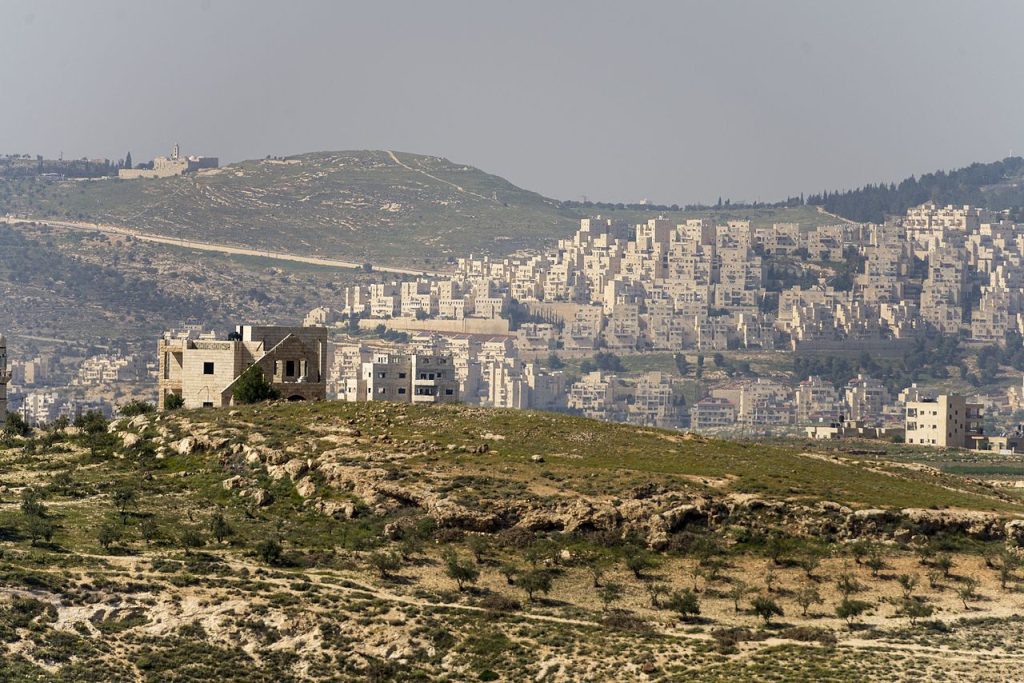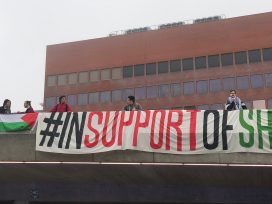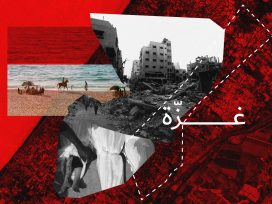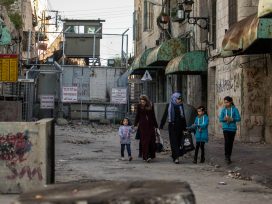‘How did the illusion arise that the “Palestine question” had vanished into thin air, and that the danger of a flare-up in the conflict between Israel and the Palestinians had been banished? The subject had been absent both from the international agenda, as well as from the recent Israeli election campaign. But then the violence erupted and the illusion was shattered: in the space of just a few days, a conflict that had been dormant turned into a conflagration – a war between Gaza and Israel.’
These lines, which I co-wrote with Shimon Stein, appeared in the Frankfurter Rundschau on 19 May 2021, shortly after Israel had launched airstrikes on the Gaza strip in response to Hamas rocket attacks.
We all know that history does not repeat itself. But just two years later, the Hamas massacre of 7 October 2023 shattered the next set of illusions and sparked an Israeli response that was even more brutal.
Historians of the twentieth century know only too well how unreliable predictions can be. The title of our article, ‘Shattered illusion’, was meant to allude to the famous book The Great Illusion by Norman Angell, published in 1909. In it, the journalist, politician and later Nobel Peace Prize winner declared that a major war between the European nations was highly unlikely, since it would not be in their economic interests. Five years later, World War I broke out.

Israeli settlement in the West Bank. Image: © Ralf Roletschek / Source: Wikimedia Commons
In the case of Israel and Palestine, the writing has been on the wall for well over half a century. Israel (and the world) knew that to sweep the problem under the carpet – to treat the occupation as normal and somehow simply ‘manage’ it – would not work indefinitely. It was obvious that the longer the violence persevered, and the more victims it claimed, the harder it would be to break the vicious cycle.
Take the most intractable problem: Israel’s settlement policy, an obstacle to peace that has grown drastically in recent decades. There are now more than 700,000 Israeli settlers, including in East Jerusalem, compared with just over 100,000 thirty years ago. This makes a qualitative difference to the prospects for a solution for the West Bank, given that it is now much harder to reverse the Israeli land seizures.
The Israel–Palestine conflict has always offered a platform to extremists. On one side there is the slogan ‘Drive all Jews into the sea’, which would mean not just abolishing the state of Israel, but also expelling and even annihilating the Jewish community in Palestine. The historical model for this is the Battle of Hittin in 1187, when the Muslim armies led by Saladin destroyed the European Crusaders and recaptured Jerusalem.
On the other side there is the messianic but increasingly mainstream vision of the Greater Israel fanatics, demanding that all Palestinians in the territory between the Jordan and the Mediterranean either live entirely under Jewish rule or be fought and driven out. In terms of their willingness to use violence, the Israeli settlers are just as trigger-happy as their Islamist Palestinian opponents.
Apocalyptic thus visions exist on both sides, rooted in the idea that an Armageddon will pave the way to a solution. In crises like the present one, the voices of those in favour of such ‘solutions’ become louder, until the possibility of them being attempted becomes real. After the Hamas massacre of 7 October, for example, Amichai Eliyahu, the far-right Minister for Cultural Heritage in Benjamin Netanyahu’s government (and the son of a rabbi), suggested dropping one of Israel’s nuclear bombs on Gaza. The suggestion earned him nothing worse than being excluded from cabinet meetings.
The best alternative
So will there never be peace between Israel and its neighbours? Thirty years ago, this question could have been answered more easily – and certainly more optimistically. Back then, all the signs in the region really did seem to point towards the ‘end of history’ and the triumph of liberal democracy: the signing of the 1993 Oslo Accords by Israel and the PLO was welcomed by both sides as the foundation for future relations between the two states.
But since the ceremonial signing of the Accords on the White House lawn in Washington, hopes for peace have been dashed by opposition to the agreement from both sides. First there was the Intifada, then Hamas came to power in Gaza. One Gaza war was followed by another, and ever-increasing settler activity in the West Bank has resulted in the weakening of its autonomous authority. All these things turned a conflict over land into a brutal religious war and led to the catastrophe of 7 October.
Whenever politicians and diplomats are asked yet again about a possible end to the conflict, they reply with a cliché about a ‘two-state solution’. However, the question is never followed up with a genuine, detailed discussion on how it could be implemented in practice. The longer the solution has been left unrealized, the louder those voices have become that say that Israel’s expanding settler policy has made a two-state solution impossible.
But if a two-state solution really is a hopeless proposition, what is the alternative? War without end? Israeli annexation of the Palestinian territories in the West Bank and Gaza? Mass expulsion of either Israelis or Palestinians? Continuation of the ‘management’ of the occupied territories that has just failed so spectacularly? Or some other form of ‘autonomy’ for the Palestinians, short of national sovereignty?
In a 2021 conversation with Shimon Stein, Micha Brumlik and myself, Omri Boehm proposed ‘self-determination in the context of a binational federation with the Palestinians’. This idea is based on Menachim Begin’s plan drawn up in 1977, shortly after Anwar Sadat’s visit to Jerusalem, which envisaged self-government for Palestinians within an extended Israel. It would have made the Palestinians Israeli citizens with equal rights. Boehm argues that this kind of democratic alternative to a two-state solution needs to be put back on the table.
But is the idea of an Israeli state throughout the territory of Palestine, which would no longer be Jewish, realistic? After all, demography would ultimately leave Jews a minority in their own country, making this ‘solution’ unacceptable to most of them from the start.
The problem is that all the alternatives to the two-state solution are either morally repellent or rejected by too many people on both sides as inacceptable, dangerous or unworkable. To put it another way: none of the alternatives has any advantage over a two-state solution. Unless we want to go back to square one, the two-state solution needs to be the starting-point for all further deliberations. After all, it was what the 1947 UN Resolution was based on and has always been the model most closely aligned with the right to national self-determination within the framework of international law.
National self-determination for both sides
The State of Israel is founded on the principle of the right to self-determination for the Jewish people. But since the land of Palestine, or Eretz Israel, is inhabited not just by Jews but also by the Palestinian, Arab people, the right to self-determination must extend to them too. Mutual recognition of this must lead to a fundamental agreement that, under international law, each of the two peoples on the territory of former Palestine has the right to a nation state.
This approach would also remove one of the biggest obstacles to peace: the notion that the state, whether Jewish or Arab Muslim, derives its legitimacy from a religious inheritance or a particular interpretation of national history. Instead, the question needs to be about the principle of self-determination.
Without this fundamental shift of mindset from religious enmity to coexistence under international law, a two-state solution will not be possible. Bringing this shift about is the most important task facing the international community. Everything else follows from it. Only once it has been achieved will it be possible to move on to detailed, concrete arrangements.
Experience shows that nation states need not be ethnically homogenous. Despite Jewish extremist organisations such as Lehava that violently oppose mixed marriages and other forms of Jewish-Arab contact, as well as wider institutional and social discrimination, anyone who has ever been inside an Israeli hospital or collected a prescription from a pharmacist knows that Arabs are an integral part of Israeli society.
The future state of Palestine would also have to be willing to accept a parallel arrangement that allows for a Jewish minority. The Israeli settlers have not just made the West Bank their place of residence; they have created pockets of Israeli sovereignty there too. This would of course need to be regulated, preferably within a constitutional framework encompassing both states. Jews who insist on living in the Palestinian territory would have to become Palestinian citizens. It would also need to be made clear that the West Bank and Gaza Strip, while geographically separate, were both part of the State of Palestine and governed by it.
However, the new constitutional structure would also ensure that Jewish people living in the territory of Palestine had the same legal protections as Arabs living in the territory of Israel. There would be no place for the Greater Israel ideology under this arrangement. At the same time, there would be no ‘Jew-free’ State of Palestine, any more than there is an ‘Arab-free’ Israel now.
This wide-angle view of the challenges must also include the refugee issue. It has always been Palestinian policy that all refugees must have the right to return, and that refugee status must be passed down from generation to generation. Israel has historically dismissed this demand out of hand. But if the goal really is to reach an agreement, and not to simply continue the conflict, practical compromises should be achievable.
Under this proposal, a federal structure would ultimately subordinate the two states to a common law. It is important to interpret the concept of ‘nation state’ freely here, and not in the way it was understood in the nineteenth century or at the end of World War I, when it was clearly based on ethnicity. Furthermore, it is possible to use the term ‘Jewish’ in a way that does not automatically provoke the other side. ‘Jewish’ and ‘liberal’ do not have to be contradictions in terms.
This is not 1648, the year that the modern system of sovereign states was established: it is the 21st century, in which 27 European states are prepared to relinquish aspects of their sovereignty to create the superstructure of the EU. This could serve as a model for the Middle East. Despite the present shift to the right, the way Europe has developed is encouraging: the continent did in the end manage to overcome longstanding, supposedly insurmountable enmities.
Before anyone accuses me of a lack of realism, I hasten to add that it will not suffice to quote Theodor Herzl’s well-known phrase, ‘If you will it, it is no dream.’ We all know that religious fundamentalism has played a catastrophic role in the Middle East, and that too many people there are systematically educated into intolerance and hatred. We know, too, that peace is not the top priority for many of the region’s powers and superpowers.
Finally, none of these difficulties can be overcome without the help of the international community, on the basis of regional agreements. It will be a mammoth task, no question; but the alternative is escalation into a regional, multi-front war, possibly even involving the use of nuclear weapons by Israel and Iran. And that must be prevented at all costs.
This article is based on the author’s latest book, Niemals Frieden? Israel am Scheideweg (Never peace? Israel at the crossroads), published by Propyläen.







